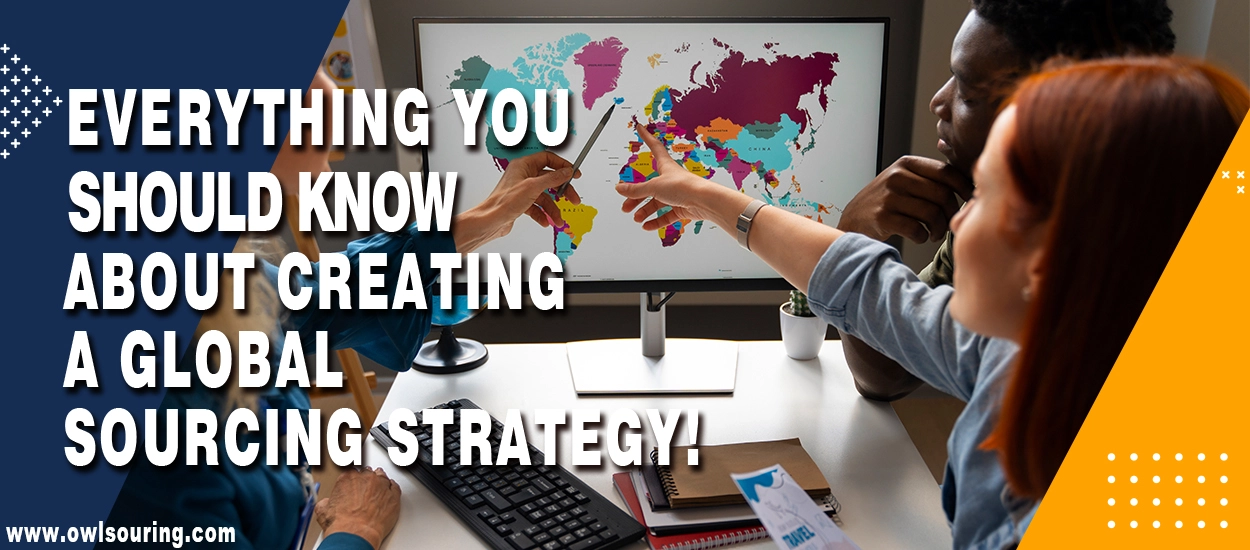Global sourcing is essential for businesses that want to stay aggressive in the market. Most companies are looking to explore other countries to improve their supply chain.
As a business person, opportunities open up when you buy goods worldwide. It helps you access new resources and specialised knowledge.
Global sourcing has many benefits and risks. A global sourcing plan must address problems as they arise.
I will examine essential areas of creating and using a global sourcing plan. It will advise you on improving your global sourcing process while lowering risks.
Why Global Sourcing Is Essential for Business Growth

Global sourcing is essential for businesses to thrive. The following are reasons global sourcing is crucial to business growth:
1) Cost Reduction Opportunities
To reduce costs, you can source from countries with cheaper labour and production. According to Hackett Group research, outsourcing lowers labour costs by 35%. These saved costs can be used to invest in new products.
It’s also beneficial in boosting profits. Yet, it’s essential to consider costs, including shipping and taxes. It helps you accurately determine what’s best for your business.
2) Access to New Markets and Resources
Global sourcing provides access to resources and markets not available locally. It may be handy if you need unique supplies or expertise. It offers specialist information from across the world.
A company may import Chinese cutting-edge technology or quality fabrics. This access may result in new possibilities and improved goods.
3) Diversification of Supply Chain
Depending on just a few local suppliers can be risky. Global sourcing helps reduce this risk by making the supply chain more diverse. With many suppliers, you may switch sources if one fails.
This strategy worked well for some businesses during the pandemic. Companies with several worldwide suppliers handled these issues well.
4) Competitive Advantage
You can get a significant edge over competitors if you maximise global sourcing. It can help improve things, get items made faster, and develop new ideas.
Working with the top Chinese suppliers ensures product quality and efficiency. Companies with strong global sourcing policies tend to lead their industries.
Key Steps in Developing a Global Sourcing Strategy

A thriving global sourcing strategy requires careful planning. The following are the most crucial phases in global sourcing strategy development:
1) Assessing Your Current Supply Chain
First, check current suppliers’ prices and operations. Figure out what could be better with global sourcing. Check for weak spots or places where things get stuck and take too long.
Consider the most crucial aspects of your firm’s supply chain. Choose where to focus your global sourcing efforts with this assessment.
2) Defining Objectives and Goals
Figure out what you want to achieve before you look for global suppliers. Make sure your global sourcing plan has clear goals. Ensure that your goals are in line with your business plan as a whole.
One goal could be to explore three new markets in the next 18 months. Having clear goals will help you figure out how well your plan worked.
3) Market Research and Analysis
For global sourcing to work, you must do much research. You need to know about the places you’re considering venturing into. Consider costs like labour, quality standards, and political stability.
Think about how regional differences could affect how you do business with others. Remember to look into any local laws or rules that could affect where you source.
4) Creating a Sourcing Plan
After doing your research, it’s time to plan where to find the things you need. It should list the goods or items you’ll get worldwide and where you’ll get them.
Your sourcing plan should also include possible risks and how you’ll handle them. Consider currency fluctuations, shipment delays, and quality control difficulties.
Identifying and Evaluating International Suppliers

Let’s explore how to identify and evaluate international suppliers:
1) Supplier Research Methods
Start your search for possible suppliers with online directories and trade sites. Many ads are on websites like ThomasNet, Global Sources, and Alibaba.
However, be cautious if you plan to buy from Alibaba. You can read more about Alibaba scams.
You can also meet sellers in person at trade shows and events specific to your industry. Learn more about the Trade Fairs in China. Pay attention to advice from people in the same business or trade groups. They often provide insights into supplier reliability.
2) Criteria for Supplier Evaluation
There are three main things you should look at when examining suppliers. These include quality, cost, and reliability. You can check my post specifying tips to verify a Chinese Supplier’s Legitimacy.
Quality is paramount, so ensure the seller can always meet your needs. Ask for samples and check everything carefully.
Cost is essential, yet it’s beyond getting the cheapest deal. Suppliers you can trust must have competitive prices, but not always the lowest. Things like on-time service, contact, and flexibility are all parts of reliability.
3) Techniques for Supplier Analysis
When looking at sources, use numeric and qualitative methods. Create a scorecard that rates suppliers on various criteria. Then, give each factor a weighted value based on its importance.
Conduct a financial study of a source to see how stable they are. The economic health of a supplier can affect how often it can fill orders. Site trips are beneficial for in-depth research. Also, you can request references from the supplier’s other clients.
4) Building Relationships with Suppliers
To begin, make your goals, quality standards, and objectives very clear. Communicating with suppliers often helps clear up confusion and builds trust. Instead of short-term ties, think about long-term agreements. When doing business with foreign suppliers, be aware of their cultural differences.
Understanding and adapting to local business practices can enhance your working relationship. Also, be open to feedback from your suppliers. They might know something valuable to help you improve your goods or methods.
Quality Control in Global Sourcing

Below are essential elements of effective quality control in global sourcing:
1) Establishing Quality Standards
Clear, measurable quality standards enhance quality control. Start by listing material, size, utility, and design requirements. These should match industry standards and your brand’s quality demands.
Consider your suppliers while creating standards. Their suggestions can help set achievable standards. Record these standards in a quality manual. It will guide your staff and suppliers. When you place your standards, incorporate international quality standards.
If you plan to source goods from China, read these posts;
2) Implementing Quality Assurance Processes
Implement quality assurance processes for the entire supply chain. This covers raw materials to finished goods. Check materials before manufacturing with inbound quality control. This step can stop problems with quality from getting worse.
For instance, there’s Statistical Process Control (SPC). It monitors and maintains product quality during production. Also, inspections before shipping are vital. It provides a final quality check before products leave the supplier’s facility.
3) Supplier Quality Management
Good supplier quality management involves constant monitoring and improvement. Regular checks of source sites help make sure that quality standards are being met. It also indicates where improvements can be made. In 2023, 62% of businesses said they did checks on their suppliers at least once a year.
Help your suppliers meet your quality standards by giving them support. Most of the time, this leads to better product quality and better ties with suppliers.
4) Continuous Improvement Strategies
Quality control is an ongoing process that needs constant improvement. Promote quality in your company and supply chain. Establish a quality problem-tracking and resolution system. Fixing problems quickly prevents recurrence.
By doing this, you show suppliers and customers you value quality. Use lean production in your supply chain. These strategies reduce waste, increase production, and improve quality.
Managing Risks in Global Sourcing

With the correct strategy, you may overcome obstacles in global sourcing. Here’s how you can manage risks in global sourcing:
1) Identifying Potential Risks
First, you need to look for possible risks. Consider supply chain breakdowns. Remember how that ship getting stuck in the Suez Canal caused much trouble? That’s just one of many ways things could go wrong.
There is also the issue of quality control. Keeping quality standards high when working with foreign suppliers is difficult. Take note of changes in currency value. Another concern is unstable governments in goods-sourcing nations.
2) Risk Assessment and Mitigation Strategies
Start by creating a risk assessment matrix. This tool lets you rank risks by likelihood and severity. Notably, the key to surviving interruptions in the supply chain is diversification. Collaborate with several providers in different locations rather than relying on one.
Strict inspection procedures should be put in place to handle quality control issues. Think about bringing in quality assurance specialists from the supplier’s home country. To make sure things are up to par before they’re shipped, they can act as your eyes and ears.
3) Insurance and Compliance Measures
Your safety nets are insurance and compliance. First, get a trade credit insurance plan. If your seller goes out of business or can’t deliver orders, this will pay for things. Marine shipping insurance can also cover goods while they are being shipped.
Keep up with all the rules that apply to you, whether they are in your own country or another country. Fines or even civil problems can happen if you don’t follow the rules.
Read More:
- What Are Amazon’s New FBA Fees and Policies?
- How to Source Products From China?
- Sourcing Personal Protective Equipment (PPE) from China
- How to Import Firefighting Equipment from China?
Final Thoughts!
Businesses can improve their supply chains and find new markets with global sourcing. The best foreign sourcing tactics fit well with the overall goals of your business. Global sourcing methods are a great way to help your business reach its goals.
Your business success depends on how successfully you adjust the global sourcing strategy. So, you may transform global sourcing challenges into competitive advantages.
If you plan to become part of global sourcing, OwlSourcing is the best agent to go for. We can help you source quality goods directly from Chinese manufacturers. Plus, we will also put a solid supply chain in place.


